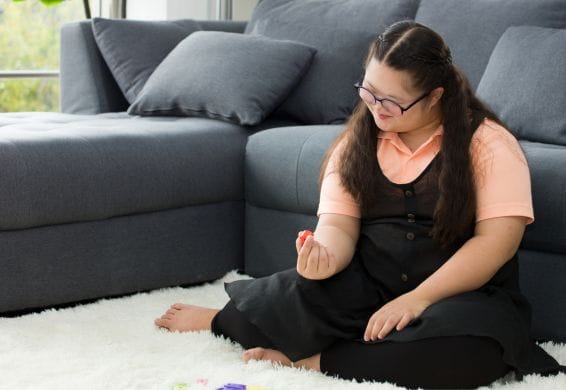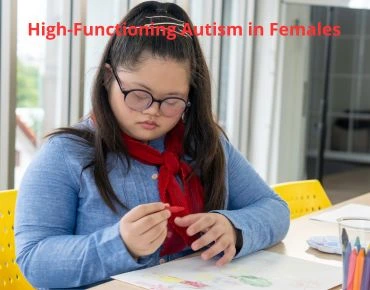High-functioning autism (HFA) is often seen in people with average to above-average intelligence. They face big challenges in social settings and communication. It’s key to spot the signs of high-functioning autism in females, as they tend to hide their traits more.
This hiding can lead to them being diagnosed less often. Signs in adults, like women, include trouble with social interactions, being very sensitive to sounds and sights, and having a hard time controlling their emotions. They also have very focused interests. Knowing these signs helps in getting the right support and diagnosis, leading to better lives for women with autism. Let’sdiscover this interesting post: High-Functioning Autism in Females Symptoms
Key Takeaways
- High-functioning autism in females may present differently than in males.
- Females are more likely to mask symptoms, complicating timely diagnosis.
- Social difficulties and sensory sensitivities are common traits.
- Emotional distress is prevalent due to camouflaging behaviors.
- Understanding these symptoms is vital for proper evaluation and support.
Table of Contents
Understanding High-Functioning Autism
High-functioning autism (HFA) is a part of the autism spectrum. It includes people with average to above-average intelligence facing social and communication challenges. This can make it hard to diagnose autism in women, as their symptoms might look like other conditions.
Women with HFA might seem like they have ADHD or OCD. This leads to them often being misdiagnosed. This lack of correct diagnosis means they miss out on important support and help during key times in their lives. People with HFA face different challenges, making it hard to generalize their experiences.
Autism in women shows up in unique ways. They might struggle with making friends and solving conflicts. They also tend to prefer routine and predictability to manage their anxiety.
Many women with HFA do stimming or repetitive behaviors, but these are less obvious than in men. They often deal with more anxiety and depression, making it tough to do well socially and at work. Getting diagnosed early is key to helping them overcome these hurdles.
Getting the right mental health services and support is vital for these women. Having structured routines helps reduce stress. It also helps them use their strengths in detail and creative problem-solving.

High-Functioning Autism in Females Symptoms
It’s important to recognize high-functioning autism symptoms in women early. Women with autism often show different signs than men. This can lead to them being missed or misdiagnosed.
Autism is more common in boys, with a three-to-one ratio. But girls with autism might seem like typical girls. They might have a big vocabulary or seem to fit in socially, hiding their autism.
Women with autism also face challenges in organizing and starting tasks. They might find it hard to switch between activities. This can cause them to miss school or work.
Women with undiagnosed autism are more likely to have anxiety and depression. They struggle with controlling their emotions. This makes it hard for them to handle stress and mood swings.
- Social Camouflaging: Many women adapt their behaviors to fit social norms, which can obscure their autism diagnosis.
- Stimming Behaviors: These are often less noticeable compared to typical presentations but still warrant attention.
- Advanced Vocabulary: A large vocabulary does not exempt individuals from struggling with communication in social contexts.

Knowing about high-functioning autism in women helps with better diagnosis and treatment. It’s crucial for professionals to understand these differences. This can greatly improve the lives of women with these challenges.
| Symptoms | Details |
|---|---|
| Social Difficulties | May include challenges in making and maintaining friendships. |
| Sensory Sensitivities | Variations can manifest as discomfort in overwhelming environments. |
| Executive Function Challenges | Difficulty planning, organizing, and prioritizing tasks. |
| Obsessive Interests | Intense focus on specific topics or activities. |
| Emotional Regulation | Struggles with managing feelings, leading to mood swings. |
The Prevalence of High-Functioning Autism in Women
Understanding the high-functioning autism prevalence among women shows a big gap in diagnosis. Autism was once thought of as a male condition. This led to a ratio of 4:1 for males with Autism Spectrum Disorder (ASD) compared to females. Now, research shows ASD in girls is about 1 in 152, while in boys it’s 1 in 38.
This highlights the need to change how we diagnose and understand autism in women.
Women with autism often show more subtle signs of autism in adults than men. For example, girls with ASD tend to have lower levels of repetitive behaviors in childhood. This subtlety can lead to delayed diagnosis and many women going undiagnosed.
Studies say up to 80% of autistic girls might not get diagnosed by age 18. This is because they can hide their symptoms well.
Women with autism often hide their traits to fit in. This makes it hard to see their unique challenges. They might show more anxiety and mood issues because of societal pressure and the emotional cost of hiding.
It’s crucial to understand the differences in symptoms and their impact. Misunderstanding can lead to wrong diagnoses, cutting off access to help. The reality of high-functioning autism prevalence in women challenges old views of autism. It calls for more awareness in communities and clinics to support those affected.
Key Characteristics of High-Functioning Autism
High-functioning autism has many characteristics of autism that differ from person to person. People with this condition often find it hard to interact and communicate socially. This can show up as trouble keeping eye contact or having two-way conversations.
Another key feature is repetitive behaviors and limited interests. These can bring comfort but might also cause people to feel left out. Some might focus intensely on certain things, which can be seen as good or bad depending on the situation.
Many women with high-functioning autism use strategies to fit in socially. This can lead to feelings of anxiety and depression inside. They might also be very sensitive to sounds, textures, and lights, making their world feel more intense.
It’s important to understand these traits to create supportive spaces. By valuing each person’s strengths, we can improve their lives. Here’s a quick overview of the main characteristics:
| Characteristic | Description |
|---|---|
| Social Interaction Challenges | Difficulty in maintaining eye contact and understanding social cues. |
| Communication Deficits | Struggles with reciprocal conversations and expressive language. |
| Intense Interests | Focused enthusiasm on specific topics that may lead to isolation if excessive. |
| Repetitive Behaviors | Engagement in repeated movements or routines that provide comfort. |
| Sensory Sensitivities | Heightened sensitivity to stimuli such as sounds, textures, or lights. |
| Emotional Regulation Issues | Prolonged emotional reactions in stressful situations. |
| Co-occurring Conditions | Presence of anxiety, depression, or ADHD more common in female diagnoses. |
By recognizing the wide range of autism traits, we can build better support systems. This helps people with autism to be themselves and live their lives fully.

Social Difficulties Faced by Females with Autism
Females with autism often face unique social challenges. These can make it hard to build and keep friendships. They might feel isolated and anxious because of these difficulties.
Challenges in Making and Maintaining Friendships
Women with high-functioning autism find it tough to make friends. They might not understand social cues well. This makes it hard to connect with others.
- Difficulty in starting conversations or engaging in small talk.
- Challenges in reciprocal communication, where an exchange of thoughts and feelings is required.
- Limited understanding of unspoken social norms, resulting in discomfort in social gatherings.
- A tendency to feel overwhelmed in group settings, leading to social withdrawal.
Understanding Social Cues and Interactions
Women with autism struggle to read social cues. This can lead to misunderstandings and conflicts. Some specific issues include:
- Struggles with understanding body language and facial expressions.
- Challenges interpreting tone of voice and other nonverbal signals.
- Potential misreadings of intentions which can result in strained relationships.
It’s important to have support systems and training for women with autism. This can help them improve their social skills and interactions.
| Challenge | Impact on Relationships |
|---|---|
| Difficulty in initiating conversations | Leads to missed opportunities for connection |
| Limited understanding of social norms | Results in social faux pas or conflict |
| Overwhelmed in group settings | Encourages withdrawal and isolation |
| Struggles with nonverbal communication | Affects the perception of trust and empathy |
The Role of Masking and Camouflaging
Masking and camouflaging are key for those with autism, more so for women. They hide their autistic traits to fit in. This is often to be accepted by society. Women with autism use complex strategies to get through social situations.
This effort can take a big emotional toll. It’s not just about hiding traits; it’s about the emotional cost of doing so.
What is Masking?
Masking means hiding or covering up autistic traits. Women might:
- Learn and remember social scripts.
- Practice making faces to look like they’re engaged.
- Force eye contact during talks.
- Stop themselves from doing things that feel good, like stimming.
- Plan what to say to make conversations easier.
Studies show up to 80% of autistic females mask. This is more common in women due to societal expectations.
The Impact of Camouflaging on Mental Health
Masking can make it seem like someone is normal, but it’s bad for mental health. Women who hide their autism often feel:
- More anxious and depressed, with anxiety rising by 50% compared to men.
- Emotionally drained from pretending, leading to burnout.
- Disconnected from themselves because they’re always pretending.
About 54% of autistic women hide their autism in public. Forced eye contact affects 95% of them. This shows how hard it is to hide autistic traits.
Sensory Sensitivities in Women with High-Functioning Autism
Sensory sensitivities are a big part of life for women with high-functioning autism. They can react strongly to different things around them. This makes it hard for them to handle their surroundings. It’s important to understand these sensitivities to help them cope better.
Types of Sensory Sensitivities
Women with autism often feel too sensitive or not sensitive enough to certain things. Here are some common types:
- Auditory Sensitivity: They might get overwhelmed by loud noises or specific sounds, causing stress.
- Visual Sensitivity: Bright lights, like those from LEDs, can be too much for them.
- Tactile Sensitivity: They might dislike certain textures or fabrics that feel uncomfortable.
- Olfactory Sensitivity: They can be very sensitive to smells, which might make them feel sick or upset.
- Gustatory Sensitivity: They might have strong likes or dislikes for certain tastes or textures of food.
Coping Strategies for Sensory Overload
Managing sensory sensitivities is key for women with autism. Here are some helpful ways to cope:
| Coping Strategy | Description |
|---|---|
| Sensory-Friendly Spaces | Creating calm areas without too much stimulation, like quiet rooms. |
| Use of Sensory Tools | Using items like fidget toys, earplugs, or weighted blankets for comfort. |
| Routine Establishment | Keeping to a regular routine to avoid sudden sensory experiences. |
| Movement Breaks | Taking short breaks for physical activity to release tension. |
| Occupational Therapy | Working with therapists to find personal ways to deal with sensory issues. |
Emotional Regulation and High-Functioning Autism
Emotional regulation is a big challenge for people with high-functioning autism, more so for women. Studies show they face intense emotions and struggle to manage them. This can make daily life more stressful and worsen autism symptoms in adults.
Mood disorders are more common in people with autism than in others. Research shows that those with higher intelligence are more likely to feel depressed and anxious. Women with autism often find it harder to manage their emotions. They might struggle to identify their feelings and use unhealthy ways to cope, like hiding their emotions.
A study with 64 young adults with autism gave us a closer look at their emotional patterns. Many of them used emotional suppression instead of better ways to handle feelings. This makes social situations harder, leading to feelings of loneliness and distress.
Creating supportive environments is key to improving emotional regulation. Positive relationships and the right help can help people manage their emotions better. This leads to more enjoyable daily experiences.
Executive Functioning Challenges
Women with high-functioning autism face big challenges in executive functioning. These include planning, organization, and time management. It’s key to understand these to help improve daily life.
Planning and Organization Difficulties
Planning is tough for women with autism. They find it hard to organize tasks and meet deadlines. This can lead to stress and frustration.
They might struggle to know the best way to do things. This makes it hard to finish tasks on time.
Time Management Skills
Managing time well is crucial for daily tasks. Women with autism often find it hard to plan and organize. About 50% of them struggle with these tasks.
Staying focused is another challenge. But, using routines can help a lot. Breaking tasks into smaller steps also helps.
| Challenge | Impact on Daily Life | Improvement Strategies |
|---|---|---|
| Planning Difficulties | Difficulty prioritizing tasks leading to stress. | Use of task lists and visual aids. |
| Organization | Struggles with task completion and time constraints. | Regular routines and breaking down tasks. |
| Time Management Skills | Challenges in integrating steps for task achievement. | Setting deadlines and reminders. |
Obsessive Interests in Autistic Females
Autistic females often have intense interests from a young age. These can range from favorite TV shows to collecting odd items. Understanding these obsessive interests autism helps us see how they cope with daily life.
These passions are key to their emotional well-being. They bring comfort and predictability. Yet, balancing these interests with social life can be tough, sometimes leading to isolation.
There’s a big difference between typical interests and those in autism. The latter are more intense and lasting, causing social challenges. For instance, autistic individuals might engage in repetitive behaviors due to their interests or to cope with stress.
To help autistic females, we need effective strategies. Creating a structured environment can reduce boredom and stress. Using visual aids, like timetables, helps manage these interests and promotes social expression.
| Aspect | Detail |
|---|---|
| Intense Interests | Provide comfort and predictability, crucial for emotional stability. |
| Common Themes | Favorite characters, dinosaurs, collection of items. |
| Impact on Social Life | Risk of isolation and difficulty in adapting to social norms. |
| Repetitive Behaviors | Include hand-flapping and rocking; often provide sensory input. |
| Strategies for Management | Use of visual supports, creation of structured environments. |
Mental Health Issues Associated with High-Functioning Autism
People with high-functioning autism often face mental health challenges like anxiety and depression. Studies show that about 70% of autistic individuals also have mental health issues. The stress of hiding their true selves can make these problems worse, affecting their overall well-being.
Anxiety and Depression
Anxiety and depression are common in those with high-functioning autism. Autistic women, in particular, may struggle more due to societal expectations. Those who hide their autistic traits more often feel emotionally drained, leading to suicidal thoughts and depression.
The Importance of Early Diagnosis
Getting an autism diagnosis early is crucial for mental health and quality of life. Women often wait 10 years for their ASD diagnosis. Early help can reduce the risk of anxiety and depression, providing better support and resources.
| Mental Health Condition | Prevalence in Autistic Adults | Prevalence in Autistic Children |
|---|---|---|
| Anxiety | 20.2% | 26% |
| Depression | 7.5% | 20.2% |
| Bipolar Disorder | 15% | 7.8% |
| Schizophrenia | 8.1% | N/A |
Diagnosis of High-Functioning Autism in Women
Diagnosing high-functioning autism in women is tricky. Symptoms in females often look different from those in males. This makes it more likely for autism to be missed in women. The numbers show a big difference: 1 in 34 boys have autism, but only 1 in 144 girls do.
Getting a correct diagnosis is key. Doctors need to know how to spot autism in women. They use tools like the Childhood Autism Rating Scale – High Functioning (CARS2-HF) to check symptoms. Scores can vary a lot, showing how different each person’s experience is.
Getting a late diagnosis can hurt a person’s social life and happiness. Many women with autism are diagnosed later because of mistaken diagnoses. This can make them feel anxious and tired from hiding their symptoms.
It’s important to know that people can be diagnosed with autism at any age. In the U.S., about 2.21% of adults have autism. This number is higher for men than women. So, it’s crucial to keep checking for autism in people of all ages.
Conclusion
Understanding autism in women, like those with high-functioning autism, shows a complex world of symptoms and challenges. Women are often missed or diagnosed later because they can hide their symptoms well. This leads to a big gap in how they are recognized compared to men.
This gap is caused by how women with autism hide their symptoms and struggle with social interactions. It shows we need to be more aware and use better ways to find autism in women.
Women with autism often have high anxiety and depression, which is a big problem. They also face sensory issues that can be very overwhelming. Helping them deal with these issues can help them do well in life and work.
Getting to know more about high-functioning autism in women helps us give them the right help. It also helps start a conversation about autism in a positive way. By supporting women with autism in a way that fits them, we can make a big difference. We can help them be recognized, supported, and celebrated for who they are.
FAQ
What is high-functioning autism (HFA)?
High-functioning autism, or HFA, is when people on the autism spectrum have average or above-average intelligence. They face challenges in social interactions and communication. It’s not an official medical term but is used informally.
What are the signs of autism in adults, specially in women?
Adults with autism, including women, often struggle with social interactions and sensory sensitivities. They may also have trouble regulating their emotions and have strong interests in specific topics. Women might hide these traits, making diagnosis harder.
How do autism symptoms in adults differ between genders?
Autism symptoms can show up differently in men and women. Women might have milder symptoms and be better at hiding them. This can make it harder to spot and diagnose them.
What are some common high-functioning autism symptoms in females?
Females with high-functioning autism often face social challenges and sensory sensitivities. They might have trouble managing their emotions and have strong interests. They also struggle with planning and organization.
Why is there a prevalence gap in diagnosing autism in women?
Autism was once seen as mostly a male disorder, with a 3:1 male to female ratio. Women often hide their symptoms better, leading to fewer diagnoses.
What are the emotional regulation challenges faced by individuals with high-functioning autism?
People with high-functioning autism might have intense emotional reactions. They struggle to control their feelings, which can cause stress in social situations and daily life.
How does sensory sensitivity affect women with high-functioning autism?
Women with high-functioning autism often have sensory sensitivities. This means they might be very sensitive to sounds, lights, or textures. It can disrupt their daily lives, so they need strategies to cope and safe environments.
What role does masking play in the lives of autistic females?
Masking is when autistic traits are hidden to fit in socially. Women might be good at this due to societal expectations. But, it can lead to mental health problems like anxiety and depression.
What are the executive functioning challenges that people with high-functioning autism may face?
People with high-functioning autism might find planning, organization, and time management hard. This affects their daily functioning. Understanding these challenges is key to providing the right support.
How can obsessive interests be both beneficial and challenging for autistic females?
Obsessive interests can bring joy and focus. But, they can also cause social challenges. Finding a balance is important so these interests can be expressed in a healthy way.
What mental health issues are commonly associated with high-functioning autism?
Mental health issues like anxiety and depression often go hand in hand with high-functioning autism. The stress of hiding autistic traits can make these problems worse. Early diagnosis and support can help.
What should be considered during the diagnosis of high-functioning autism in women?
Diagnosing high-functioning autism in women requires understanding the subtle signs. A thorough evaluation by experts is needed to spot these signs and provide the right support.
Discover Our Post: 6 Early Signs Of Autism in Children: What to Watch For
